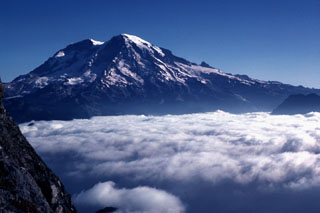Report on Rainier (United States) — 9 July-15 July 2025
Smithsonian Institution / US Geological Survey
Weekly Volcanic Activity Report, 9 July-15 July 2025
Managing Editor: Sally Sennert.
Please cite this report as:
Global Volcanism Program, 2025. Report on Rainier (United States) (Sennert, S, ed.). Weekly Volcanic Activity Report, 9 July-15 July 2025. Smithsonian Institution and US Geological Survey.
Rainier
United States
46.853°N, 121.76°W; summit elev. 4392 m
All times are local (unless otherwise noted)
The Cascades Volcano Observatory (CVO) reported that a seismic swarm at Rainier that began at 0129 on 8 July continued through 15 July, though at a slower rate. As of 1100 on 15 July CVO and the Pacific Northwest Seismic Network (PNSN) had located 540 events since the start of the swarm; many more could not be located. The rate of earthquakes decreased from 33 located events per hour at the swarm's peak during the morning of 8 July to a couple events per hour by 9 July; the rate remained at the lower rate during the rest of the week. The largest event of the swarm was a M 2.4 that occurred at 1223 on 11 July. The Volcano Alert Level remained at Normal (the lowest level on a four-level scale) and the Aviation Color Code remained at Green (the lowest color on a four-color scale).
Geological Summary. Mount Rainier is a heavily glaciated andesitic volcano in the Puget Sound region. Large Holocene mudflows from collapse have reached as far as the Puget Sound lowlands. The present summit was constructed within a large crater breached to the NE, formed by collapse during a major explosive eruption about 5,600 years ago that deposited the widespread Osceola Mudflow. Rainier has produced eruptions throughout the Holocene, including about a dozen during the past 2,600 years; the largest of these occurred about 2,200 years ago. The present summit cone is capped by two overlapping craters. Extensive hydrothermal alteration of the upper portion of the volcano has contributed to its structural weakness; an active thermal system has caused periodic melting on flank glaciers and produced an elaborate system of steam caves in the summit icecap. Reported uncertain 19th-century eruptions, including a possible but not confirmed phreatic eruption in 1894, have not left identifiable deposits.
Source: US Geological Survey Cascades Volcano Observatory (CVO)

